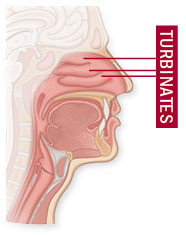Bothered by a stuffed-up nose?
Your breathing may be blocked by a chronic condition or a structural problem. Here's what you can do about it.
- Reviewed by Anthony L. Komaroff, MD, Editor in Chief, Harvard Health Letter; Editorial Advisory Board Member, Harvard Health Publishing
 Feeling like you have a stuffy nose all the time, for more than a couple of months, probably isn't the result of some cold you picked up. It's likely due to a chronic condition or obstruction that's reducing the amount of air passing through your nose. That can make it harder to breathe, and it can interfere with sleep and quality of life.
Feeling like you have a stuffy nose all the time, for more than a couple of months, probably isn't the result of some cold you picked up. It's likely due to a chronic condition or obstruction that's reducing the amount of air passing through your nose. That can make it harder to breathe, and it can interfere with sleep and quality of life.
Why are you stuffed up?
The following problems can block the passages or airways on one or both sides of your nose.
Allergies or chronic sinus problems. The inside of your nose is lined with a layer of sensitive tissue called the mucosa. It can become chronically inflamed by allergies, reducing the space left for air flow.
Enlarged turbinates. The turbinates are structures inside the nose that warm and filter air as it passes. Environmental irritants (such as smoke), hormone changes, and allergies and chronic sinus problems can inflame the mucosa lining the turbinates: as they swell up, the nasal passages narrow.
Nasal valve compromise. That's a fancy name describing a structural narrowing in certain areas of the nasal passages. It can occur as the result of injury, the nasal structure you were born with, nose surgery, or simply aging.
"Everything sags as we age, including tissue in the nose. It loses elasticity, and without that support you can develop narrowing in the nasal passages — even if you've been breathing through your nose without any problems your whole life. It seems like you've suddenly developed this new symptom," says Dr. Robin Lindsay, a facial plastic and reconstructive surgeon at Harvard-affiliated Massachusetts Eye and Ear.
A deviated septum. The septum is the wall dividing the left and right sides of the nose. You might have been born with a crooked septum, or it might have become misshapen in an accident. "As a result, it can be harder to breathe through one or both sides of your nose, even at low levels of activity," Dr. Lindsay says. "And a deviated septum that was never a problem before can cause symptoms if there's also nasal valve compromise and a loss of support tissues."
Nasal polyps. These noncancerous (benign) tumors grow along mucosa or sinuses and can block airflow.
|
Blockages in the nasal passages, such as enlarged turbinates, make breathing harder. Image: © Refluo/Getty Images |
Seeking help
The cause of nasal obstruction won't be as plain as the nose on your face. You'll have to see an ear, nose, and throat specialist (ENT), also called an otolaryngologist, to figure out what the problem is.
The ENT will ask about your medical history and the symptoms you're experiencing, and then look inside your nose to see what's blocking airflow. The specialist might also order allergy testing. (This involves inserting tiny amounts of allergens into your skin through a series of pinpricks on your arm or back. A skin reaction to a particular allergen will indicate that you have an allergy to it.)
Treatment
Strategies to reclaim real estate in your nasal passages depend on the cause of obstruction. If you have allergies, sinus problems, or enlarged turbinates, you may need a steroid nasal spray or other medications to tame inflammation. If the turbinates don't shrink with nasal sprays, you may need an office procedure or surgery to reduce them. Removing polyps is accomplished with medication that shrinks them or with surgery.
Passageways narrowed from nasal valve compromise can be treated with surgery or (in certain cases) noninvasive office procedures that either inject support implants into the nose or remodel the nose using radiofrequency energy. But such procedures aren't the first line of defense. "We'll try steroid sprays if inflammation of the mucosa is contributing to symptoms.," Dr. Lindsay says. "And you can try to open the nasal passages by using nasal dilators — either an adhesive strip you wear on the nose to gently pull the passages apart, or small cone-shaped devices that you insert into the nostrils. If either of these improves symptoms, it's likely that nasal valve correction surgery will also help."
Dr. Lindsay says the only way to straighten a deviated septum is with a surgery called a septoplasty. In people with both a deviated septum and nasal valve compromise, the procedures are performed together. "Most people get back to normal activity in about two weeks, but that can vary depending on your health and the extent of your surgery," Dr. Lindsay says.
Don't let the possible prospect of surgery keep you from seeking treatment, however. "Find out what's causing the problem first," Dr. Lindsay says. "The fix may be simple, and it may bring you a great deal of relief."
Image: © Blueastro/Getty Images
About the Author

Heidi Godman, Executive Editor, Harvard Health Letter
About the Reviewer

Anthony L. Komaroff, MD, Editor in Chief, Harvard Health Letter; Editorial Advisory Board Member, Harvard Health Publishing
Disclaimer:
As a service to our readers, Harvard Health Publishing provides access to our library of archived content. Please note the date of last review or update on all articles.
No content on this site, regardless of date, should ever be used as a substitute for direct medical advice from your doctor or other qualified clinician.

















